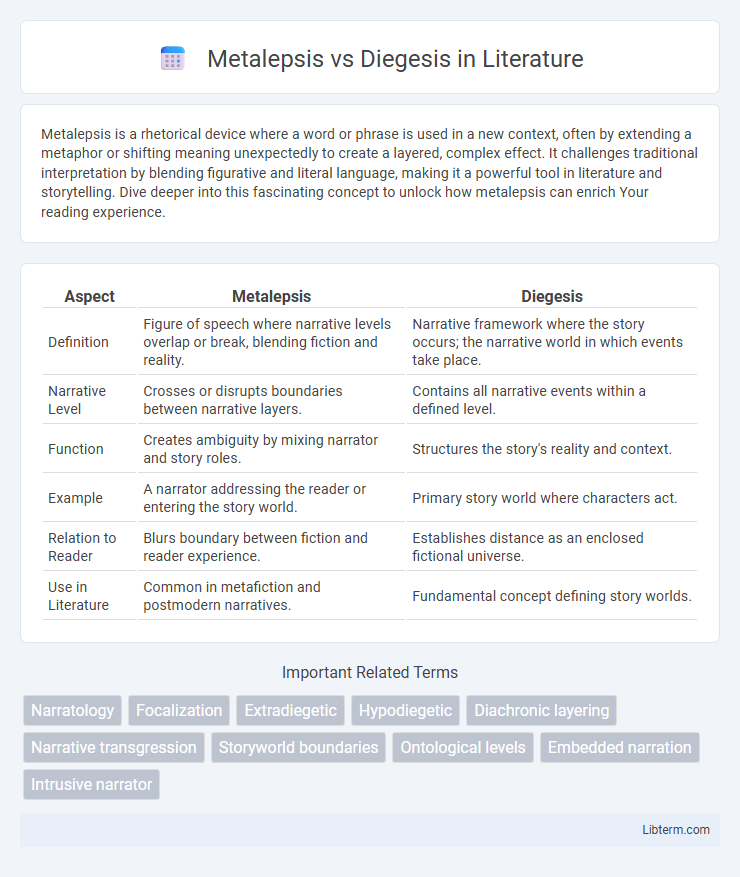Metalepsis is a rhetorical device where a word or phrase is used in a new context, often by extending a metaphor or shifting meaning unexpectedly to create a layered, complex effect. It challenges traditional interpretation by blending figurative and literal language, making it a powerful tool in literature and storytelling. Dive deeper into this fascinating concept to unlock how metalepsis can enrich Your reading experience.
Table of Comparison
| Aspect | Metalepsis | Diegesis |
|---|---|---|
| Definition | Figure of speech where narrative levels overlap or break, blending fiction and reality. | Narrative framework where the story occurs; the narrative world in which events take place. |
| Narrative Level | Crosses or disrupts boundaries between narrative layers. | Contains all narrative events within a defined level. |
| Function | Creates ambiguity by mixing narrator and story roles. | Structures the story's reality and context. |
| Example | A narrator addressing the reader or entering the story world. | Primary story world where characters act. |
| Relation to Reader | Blurs boundary between fiction and reader experience. | Establishes distance as an enclosed fictional universe. |
| Use in Literature | Common in metafiction and postmodern narratives. | Fundamental concept defining story worlds. |
Introduction to Metalepsis and Diegesis
Metalepsis and diegesis are narrative concepts that explore the relationship between different levels of storytelling. Diegesis refers to the fictional world where characters and events exist within the story, while metalepsis involves the transgression between narrative levels, blurring the boundaries between the narrator, characters, and audience. Understanding these frameworks is essential for analyzing complex narratives where reality and fiction intersect.
Defining Metalepsis in Narrative Theory
Metalepsis in narrative theory occurs when the boundaries between narrative levels collapse, causing a transgression between the story world and the storytelling discourse. This phenomenon challenges the traditional diegetic hierarchy by allowing characters or narrators to interact across different narrative planes. Metalepsis disrupts the clear distinction of diegesis, intensifying reader awareness of the narrative's constructed nature.
Understanding Diegesis: The Narrative World
Diegesis refers to the narrative world inhabited by characters, settings, and events within a story, representing the internal reality recognized by both the narrator and audience. It encompasses all elements that exist within the fictional universe, including background information, character experiences, and the story's temporal and spatial boundaries. Understanding diegesis is crucial for analyzing how narratives construct immersive worlds and differentiate between what is directly shown (mimesis) and what is told (diegesis).
Historical Perspectives on Metalepsis and Diegesis
Historical perspectives on metalepsis and diegesis trace back to classical rhetoric and narratology, where diegesis referred to the narrated world while metalepsis described the transgression between narrative levels. Gerard Genette's transformational work redefined these concepts within literary theory, emphasizing metalepsis as a narrative device blurring boundaries between the story and its telling. This evolution highlights the enduring significance of metalepsis and diegesis in understanding narrative structure and the complexities of storytelling across historical contexts.
Key Differences Between Metalepsis and Diegesis
Metalepsis involves a narrative technique where the boundary between different levels of storytelling collapses, allowing characters or events from the story world to interact with the narrator's level or reality, creating a layered and self-referential structure. Diegesis refers to the actual narrative world where all the story events, characters, and actions occur within the internal logical framework of the tale. The key difference lies in metalepsis' transgression of narrative levels, breaking the fourth wall or blending storytelling layers, whereas diegesis strictly adheres to the contained fictional universe without disrupting narrative boundaries.
Functions of Metalepsis in Storytelling
Metalepsis functions in storytelling by blurring boundaries between narrative levels, enabling characters or narrators to cross into each other's worlds and challenge the structure of the story. This technique enhances narrative complexity and engages audiences by creating layers of meaning and self-reflexivity. It often serves to emphasize thematic elements, such as the interplay between reality and fiction, or to disrupt temporal and spatial continuity within the narrative.
Diegetic Levels and Narrative Structure
Diegetic levels define the layers of narrative reality within a story, distinguishing primary events from embedded narratives or metafictional elements. Metalepsis occurs when boundaries between these diegetic levels blur, disrupting the conventional narrative hierarchy and often involving characters or narrators crossing into different narrative planes. Understanding diegetic levels is crucial in analyzing narrative structure, as it reveals how stories are framed, nested, and manipulated to create complexity and intertextual meaning.
Famous Examples of Metalepsis in Literature and Film
Metalepsis blurs the boundary between narrative levels, often allowing characters to cross into different story layers, as famously illustrated in Italo Calvino's "If on a winter's night a traveler," where the narrative self-referentially addresses the reader. In film, Federico Fellini's "8 1/2" exemplifies metalepsis by merging the protagonist's memory, fantasy, and reality, creating a fluid narrative structure. Such examples reveal how metalepsis challenges traditional diegesis by disrupting the linear storytelling framework and engaging audiences in a multilayered experience.
Impact of Diegesis on Reader Engagement
Diegesis shapes the narrative world by framing the story through an all-encompassing narrator, which immerses readers in the plot's internal logic and emotional dynamics. This narrative mode often fosters deeper reader engagement by providing insights into characters' thoughts and background details that enrich understanding. The controlled delivery of information in diegesis influences readers' emotional investment and interpretation of the story's events.
Conclusion: Metalepsis vs Diegesis in Modern Narratives
Metalepsis blurs boundaries between narrative levels, challenging traditional diegetic structures by allowing characters or events to cross into different layers of storytelling. In modern narratives, this technique enhances complexity and viewer engagement by disrupting linear storytelling and inviting interpretive exploration. The interplay between metalepsis and diegesis reflects evolving narrative strategies that emphasize reflexivity and multidimensional perspectives within contemporary media.
Metalepsis Infographic

 libterm.com
libterm.com